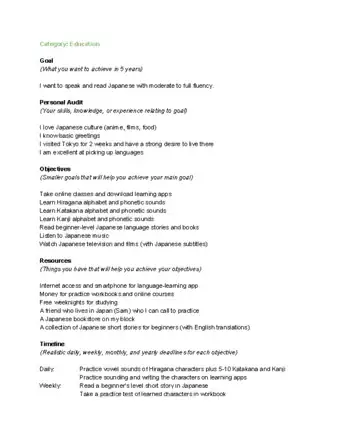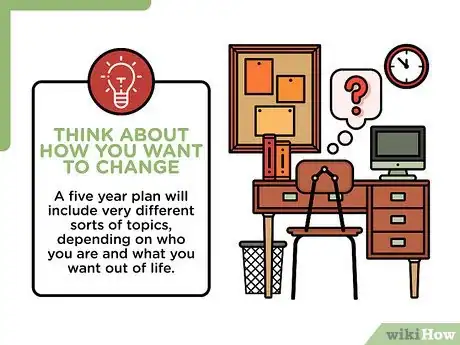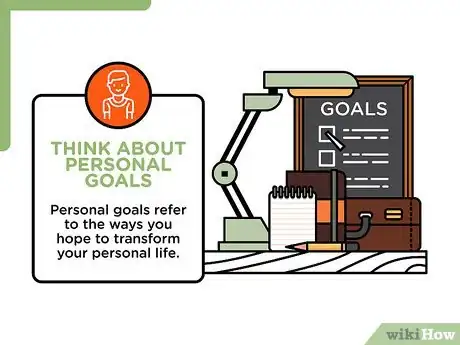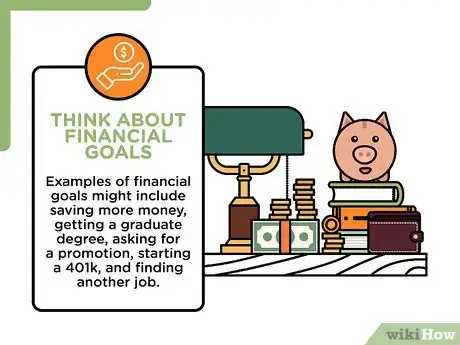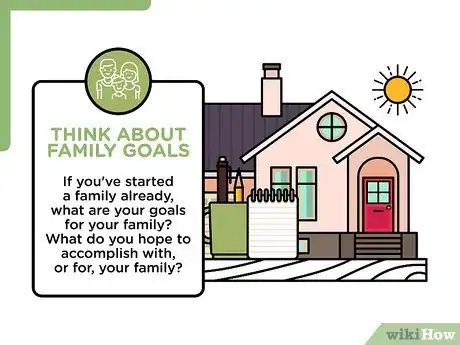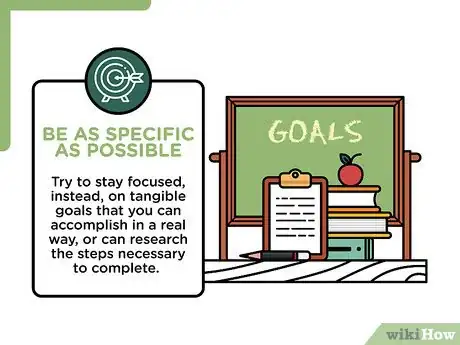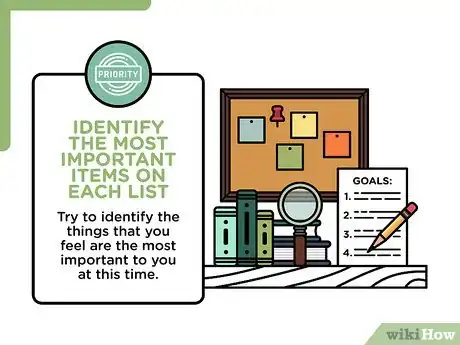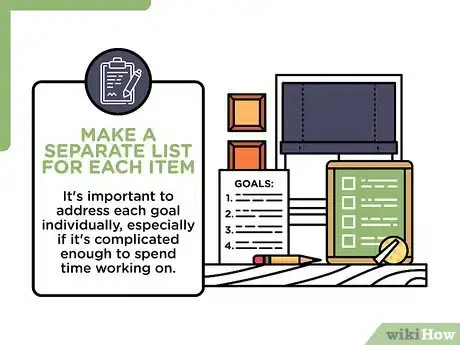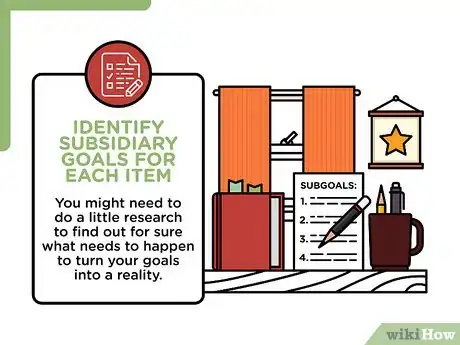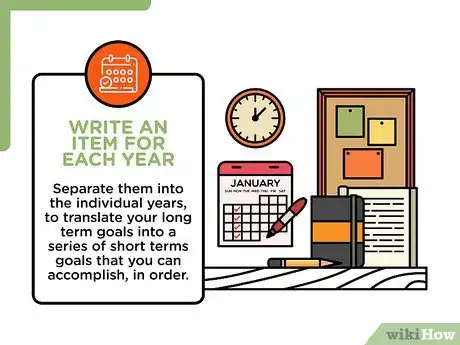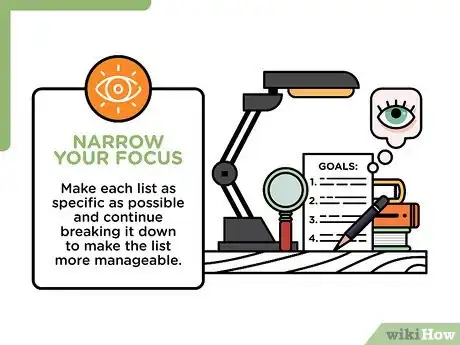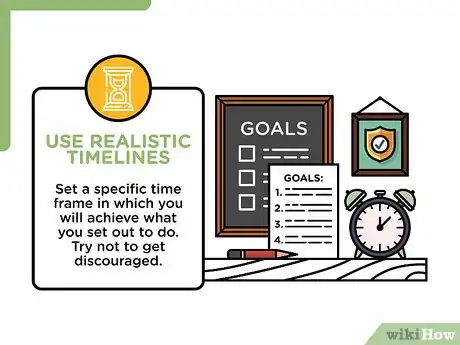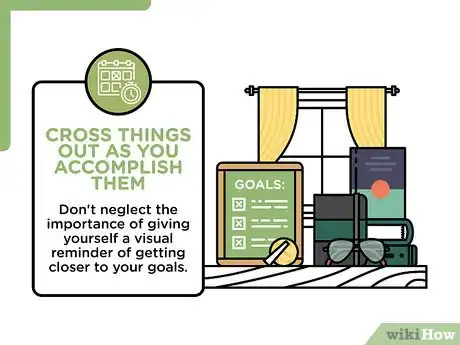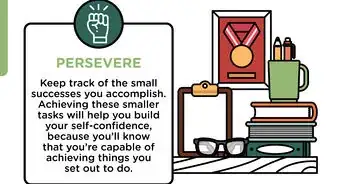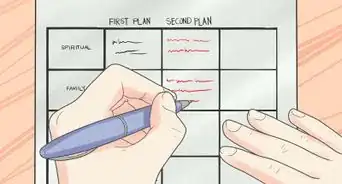This article was co-authored by Shannon O'Brien, MA, EdM. Shannon O'Brien is the Founder and Principal Advisor of Whole U. (a career and life strategy consultancy based in Boston, MA). Through advising, workshops and e-learning Whole U. empowers people to pursue their life's work and live a balanced, purposeful life. Shannon has been ranked as the #1 Career Coach and #1 Life Coach in Boston, MA by Yelp reviewers. She has been featured on Boston.com, Boldfacers, and the UR Business Network. She received a Master's of Technology, Innovation, & Education from Harvard University.
wikiHow marks an article as reader-approved once it receives enough positive feedback. This article has 16 testimonials from our readers, earning it our reader-approved status.
This article has been viewed 768,965 times.
Meeting life goals is difficult without a careful and detailed plan. While it may seem daunting or intimidating to think that far into the future, you can learn to break down your long term goals into a series of detailed steps to make big tasks much more manageable.[1] Learn to choose the right categories for a five year plan, draw up a draft, and start working your way through the list.
Steps
Sample Five-Year Plans
Choosing Categories
-
1Think about how you want to change.[2] A five year plan will include very different sorts of topics, depending on who you are and what you want out of life. What will make your life easier? What will make you a happier person?[3]
- Visualize yourself, as you see yourself, in five years. Where do you see yourself living? What do you see yourself doing?
- It's possible that you're already quite happy and satisfied in your life and you want your five year plan to continue on the path you're already on. If that's the case, think more about what you'll need to continue living the way you enjoy.
Tip: Be as honest as possible. Don't think about what you feel is expected of you — instead, think about what truly makes you happy.
-
2Think about personal goals. Personal goals refer to the ways you hope to transform your personal life. Are you happy with who you are and what you do? How would you like to change yourself? This can be anything from being more active in the dating game to picking up the banjo as a hobby. How would you like to change the way you spend your free time in the coming years? How would you like to better yourself? Think about what you want for yourself separate from what your spouse, friends, or family want for you.[4] A few examples of possible personal goals for the next five years might include:[5]
- Starting a novel
- Watching less television
- Quitting smoking
- Starting a band
- Getting more exercise
Advertisement -
3Think about financial goals. How can you use the next five years of your life to move toward financial security? How can you make steps that will get you closer to having the kind of career you want to have. Even if you're young, and don't have a job yet, thinking some about what you want out of a job now will help you find out what the next step to take is. Examples of financial goals might include:[6]
- Saving more money
- Getting a graduate degree
- Asking for a promotion
- Starting a 401k
- Finding another job
-
4Think about fun goals. It's also good to spend some time thinking about fun things you'd hope to accomplish over the next few years. Where would you like to travel? What would you like to have done by the time you spin five more times around the sun? Fun goals might include:
- Sky-diving, at least once
- Going on a blind date
- Hiking the Cumberland Gap
- Traveling abroad
- Going to a music festival
-
5Think about family goals. If you've started a family already, what are your goals for your family? What do you hope to accomplish with, or for, your family? If you haven't started a family yet, but are in the early stages, what are your plans? What can you start doing now to prepare for the future. Family goals, might include:[7]
- Having a child
- Saving money for your child's education
- Starting your child in school
- Adding on to your home
- Moving to a larger home
- Going on a family vacation
Drawing Up the List
-
1Be as specific as possible. It's hard to know what to do with something on a five year plan list like, "Be a better person," because it's hard to define what will make that so. Try to stay focused, instead, on tangible goals that you can accomplish in a real way, or can research the steps necessary to complete.[8] Be as specific as possible and your plan will have a much higher chance of succeeding.[9]
-
2Identify the most important items on each list. In each category, Try to identify the things that you feel are the most important to you at this time. Try to keep it to no more than a handful of important goals, because you need to narrow your focus and think specifically about the subsidiary goals for each item.[10]
- In the margin of each list, label every item on the list either A, B, or C. Label an A goal as a goal that is extremely important to you and that you want or need the most. Label a C goal as something that would be nice to have, but isn't something that you really want or need. If a goal is in between the two categories, label it a B goal. In order to find out what your priorities are, be as honest as possible.
Tip: Alternatively, you could also organize your list in order of how long it will take you to accomplish them. If you've got "learn to speak Italian" on your list as well as "get organized," you can take drastic steps toward one in the next week, while the other may take a lot longer.
-
3Make a separate list for each item. Once you've organized your list into the most important items of your five year plan, it's time to get out a new piece of paper, or open a new document. It's important to address each goal individually, especially if it's complicated enough to spend time working on.
- If you identified, "Get a graduate degree" on your list as an important item, make a separate list for each goal that you identify as being very important, such as this. Even if it seems simple, something like, "Get organized," it's still important to treat that with as much attention as possible.
-
4Identify subsidiary goals for each item. What needs to happen for you to accomplish your long term goal of getting organized, or of getting a graduate degree? What needs to happen for your goal to become a reality?[11]
- You might need to do a little research to find out for sure what needs to happen to turn your goals into a reality.
-
5Write an item for each year. Once you have your subsidiary goals in place, separate them into the individual years, to translate your long term goals into a series of short terms goals that you can accomplish, in order. What needs to be accomplished to move closer to meeting your goal by the end of year one? Year two? What can you do today to start moving toward your long-term goals?
Tip: For some goals, it might help to start working backward. Imagine yourself as you'd like to imagine yourself in five years, and then imagine what needed to happen for you to get there. If you imagine yourself with a graduate degree and a good job, living on a mountain somewhere, what needed to happen in the weeks leading up to that image of your yourself? What needed to have happened the previous year?
-
6Narrow your focus. Make each list as specific as possible and continue breaking it down to make the list more manageable. How deep you get will depend on how much you have to add to each item on the list, and how much guidance you require for a five year plan. If you want to get a graduate degree in the next five years, what do you hope to have done by the end of this year? What can you finish at the end of the week to move yourself closer? What can you do right now? [12]
Tackling the List
-
1Use realistic timelines. Set a specific time frame in which you will achieve what you set out to do. If you wanted to run the Boston Marathon, you might give yourself a time frame more around a year or two, instead of trying to rush things.[13]
- Try not to get discouraged. Remember, you're thinking long term. Keep breaking down those big goals until they become a small series of things you can do. Set smart goals and make plans to accomplish them.
-
2Cross things out as you accomplish them. Don't neglect the importance of giving yourself a visual reminder of getting closer to your goals. Keep your five year plan somewhere easily accessible and cross each item out when you're finished with it. This will help give you a visual reminder of your accomplishments.
Tip: Take a minute to celebrate each time you finish something. You're getting that much closer to accomplishing a life goal, so treat yourself to something special. Dinner, drinks, a spa day. Take some time for yourself.
-
3Pay attention to what new objectives present themselves. Five year plans can be a moving target. The job market can change drastically and quickly, and the more you move up the job ladder, the more you'll learn about what it takes. It might have seemed straightforward to get a job as a lawyer in five years a couple years ago, but deep into law school, now you've got a better sense of what needs to happen.[14]
- Periodically amend your list of goals to take into account these new observations and goals that come up. Revise your five year plan to account for the new information. This isn't a failure, it's a sign you're learning more and getting closer to those goals.
-
4Memorize the highlights for job interviews. A hidden benefit of the five year plan is that often employers will ask you to describe yours in a job interview. If you have prepared one, discussing it in specific detail can do a lot to present yourself as a dedicated and organized person, with clear goals in mind.[15] Contextualize the job that you're applying for as part of that goal and you're much more likely to appear like an attractive candidate.
Expert Q&A
Did you know you can get expert answers for this article?
Unlock expert answers by supporting wikiHow
-
QuestionWhat should I keep in mind when setting goals for myself?
 Shannon O'Brien, MA, EdMShannon O'Brien is the Founder and Principal Advisor of Whole U. (a career and life strategy consultancy based in Boston, MA). Through advising, workshops and e-learning Whole U. empowers people to pursue their life's work and live a balanced, purposeful life. Shannon has been ranked as the #1 Career Coach and #1 Life Coach in Boston, MA by Yelp reviewers. She has been featured on Boston.com, Boldfacers, and the UR Business Network. She received a Master's of Technology, Innovation, & Education from Harvard University.
Shannon O'Brien, MA, EdMShannon O'Brien is the Founder and Principal Advisor of Whole U. (a career and life strategy consultancy based in Boston, MA). Through advising, workshops and e-learning Whole U. empowers people to pursue their life's work and live a balanced, purposeful life. Shannon has been ranked as the #1 Career Coach and #1 Life Coach in Boston, MA by Yelp reviewers. She has been featured on Boston.com, Boldfacers, and the UR Business Network. She received a Master's of Technology, Innovation, & Education from Harvard University.
Life & Career Coach I think a mistake people often make is setting a goal that's not theirs. If you're setting a goal because it's what your spouse, friend, or parent thinks is impressive, that's a mistake. Try to only set goals that are really for yourself, and try to focus on one goal at a time. If you focus on one goal rather than 20, you're more likely to achieve it.
I think a mistake people often make is setting a goal that's not theirs. If you're setting a goal because it's what your spouse, friend, or parent thinks is impressive, that's a mistake. Try to only set goals that are really for yourself, and try to focus on one goal at a time. If you focus on one goal rather than 20, you're more likely to achieve it.
References
- ↑ Shannon O'Brien, MA, EdM. Life & Career Coach. Expert Interview. 10 December 2019.
- ↑ Shannon O'Brien, MA, EdM. Life & Career Coach. Expert Interview. 10 December 2019.
- ↑ https://ctb.ku.edu/en/table-of-contents/structure/strategic-planning/create-objectives/main
- ↑ Shannon O'Brien, MA, EdM. Life & Career Coach. Expert Interview. 10 December 2019.
- ↑ https://www.ucop.edu/local-human-resources/_files/performance-appraisal/How%20to%20write%20SMART%20Goals%20v2.pdf
- ↑ https://ctb.ku.edu/en/table-of-contents/structure/strategic-planning/create-objectives/main
- ↑ https://ctb.ku.edu/en/table-of-contents/structure/strategic-planning/create-objectives/main
- ↑ Shannon O'Brien, MA, EdM. Life & Career Coach. Expert Interview. 10 December 2019.
- ↑ https://www.health.state.mn.us/communities/practice/resources/phqitoolbox/objectives.html
- ↑ Shannon O'Brien, MA, EdM. Life & Career Coach. Expert Interview. 10 December 2019.
- ↑ https://www.ndis.gov.au/participants/creating-your-plan/setting-goals/how-will-you-pursue-your-goals
- ↑ https://www.health.state.mn.us/communities/practice/resources/phqitoolbox/objectives.html
- ↑ https://www.ucop.edu/local-human-resources/_files/performance-appraisal/How%20to%20write%20SMART%20Goals%20v2.pdf
- ↑ https://ctb.ku.edu/en/table-of-contents/structure/strategic-planning/create-objectives/main
- ↑ Shannon O'Brien, MA, EdM. Life & Career Coach. Expert Interview. 10 December 2019.
About This Article
To write a five year plan, come up with some goals that are as specific as possible, which will make them easier to track. For example, instead of saying "I want to be making more money," you could say "I want my salary to increase by 15 percent." Once you've made a list of goals, write out a plan for achieving each one. Also, break your goals up into a series of short-term goals so that you feel like you're accomplishing things along the way. For help choosing goals and working toward achieving them, keep reading!

